
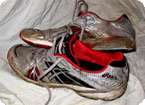


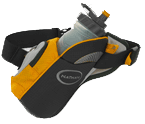

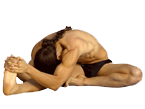


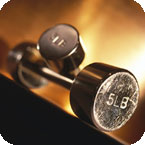
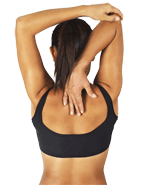
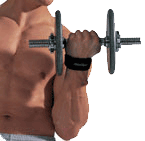
|
Running to Burn Fat
If your goal is to lose body fat and to control your weight, then you need to concentrate on distance running for a minimum period of 30 minutues (around 3 - 8 miles). The speed should be consistant for the whole period, and should be comfortable enough for you to talk, but fast enough for you to still break into a sweat. This slower pace will encourage your body to utilise fat reserves for fuel rather than carbohydrates you may have eaten earlier on.
Running for Fight Endurance
The simularity of energy used during interval running and Muay Thai training, makes this our sport specific style of choice. Interval running allows a fighter to develop both aerobic and anaerobic capacities, duplicating the demands of competition. By running hard (fast enough that talking is not easy, but slow enough so you are not gasping for air) for a three minute duration, then walking for one minute while breathing deeply and trying to recover, you will develop the specific kind of fitness required to fight. To make this style of running effective, you should run consistently for a minimum of 30 minutes (3 to 6 miles).
Sprint running helps develop the intense high level, short term energy bursts that you need during a fight. Begin your run by slowly jogging for one minute and then sprinting flat out for fifteen seconds. Returning to the slow jog for another minute, then repeating the cycle continuously until you have fatigued (around 15 minutes, 1 to 2 miles). By running in this way, you will slow the on-set of exhaustion and increase your anaerobic capacity, enabling you the ability to switch on a burst of energy anytime during training or fighting.
The best style of running to mimic a fight has to be fartlek running. With this style of running you need to run the random extremes for a minimum of 35 minutes (around 2-4 miles) to duplicate real fight conditions. Fartlek running is a random combination of the above techniques, but also includes the element of inclines and declines (hills). This style of running is best done on a treadmill or with an experienced runner, where you will be pushed to cope with different speeds and surface angles (inclined or declined). To add an additional element to this style of running, you should try to set your course across as many different terrains as possible, such as tarmac, grass, concrete, mud and shingle. During this run your body should be pushed to the maximum level of difficulty that you can sustain, this will be a good indicator to see what level of fitness you are currently at.
Conclusion
Utilising the first three styles of these running methods in your training regime, will multiply the benefits. For example, running at a slow pace will help you cut some fat and weight, but you will not be developing your aerobic capacity.
Pushing your running pace in the interval running sessions, your aerobic capacity is forced to increase. This in turn will mean that you can run faster without getting out of breath, so you will burn more fat calories per minute when you return to a slow paced distance run.
Burning extra fat will also make you lighter, increasing your power to weight ratio and making you more efficient during your interval and sprint pad workouts.
The fourth and final style of running should be used as a guide, to check what level of fitness, strength, endurance and will power you have gained. By bringing fartlek running into the equasion, we can now easly see how you are progressing towards your final goal of being fighting fit!
Choosing the right shoe for your feet - Runnersworld
Where to buy quality shoes at a decent price - M&M Sport
Weight Training for Increased Muscle Mass and Strength
To develop increased muscle mass and strength we need to work on heavy loads, slowly through the full plain of muscle movement. The heavy sustained load on the muscles will stimulate them to overdevelop and grow. This form of weight training can help where you don't have adequate strength in your calves or biceps. You should try to peform 3 sets of *6-12 reps using approximately 80-90% of your one rep max.
When working for muscle mass you should ensure that you have a spotter (someone who is there just incase you can not lift the weight) who can encourage you through the task, and give you a helping hand if you need it. It is very important that you should try to work slowly, consistently and know when enough is enough. Remember that in order to put on muscle mass you will need to take in more calories by eating more, makeing sure that you have a good balance of proteins and carbohydrates.
.........*if you can not do 6 reps with a weight, it is too heavy
.........*if you can do more than 12 reps with a weight, it is too light
Weight Training for Improved Muscle Tone and Strength Endurance
To develop improved muscle tone and strength endurance we need to work on moderate loads, at a moderate rate of speed through the full plain of muscle movement. The steady pace with a moderate weight will cause the muscle to denson, and develop more naturaly. This form of weight training most resembles a Muay Thai workout and helps with the development of sustained strength endurance needed whilst competing. You should try to peform 3 sets of 15 - 25 reps using approximately 60-70% of your one rep max.
When working for muscle tone and strength endurance, it would be fair to say that a full body workout plan could be implemented. Remember however, for the best results in your training and competitions, you should stick with forms that replicate movements within Muay Thai.
Another strength endurance method employs a light load worked at an explosive fast pace through the full plain of muscle movement. The fast pace with a light weight will help educate the muscles and develop fast twitch muscle fibres (fast twitch muscle fibres are those developed by sprinters and slow twitch muscle fibres are those developed by marathon runners). This form of weight training helps develop the explosive attacks that you need when competing. You should try to peform as many repetitions as possible within a defined time period (one minute working, one minute resting), using approximately 30-50% of your one rep max.
When working for strength endurance, you should work on sport specific exercises. For example the arms punching out dumb bells in a shoulder lift or bench pressing is very effective, and for the legs explosive squated shoulder press’s up onto your toes or seated leg lifts are best.
Conclusion
For all of your training, whether its weights, running, sparring, calisthenics or pad workouts, it is important to have a well balanced diet to help the body perform at its optimum. It is also just as important to make sure that you are getting adequate quality sleep (7-8 hours), as this will allow the body to repair the damage done during your training sessions and help with your muscle growth. You should also ensure that all of your weight training exercises are sport specific, so that they help you in competition by complimenting your pad and sparring sessions.
Supplements for training and nutrition - Maximuscle
Muay Thai specific fitness articles by Don Heatrick - Martial Concept
........What are Reps? - Reps or Repetitions, are the number of consecutive lifts
..........................................that you perform with a weight.
........What are Sets? - Sets are the number of times, you complete a number of
.........................................Reps.
........Example ‘Sets’ & ‘Reps’ - If you was to do 3 sets of 10 reps, you would have
........................................................just lifted a weight 10 times in succession, and
........................................................then repeated these 10 lifts another 2 times.
........What is a One Rep Max? - One Rep Max, is the most amount of weight that
..........................................................you can lift once only.
........What is Muscle Plain of Movement? - It is the movement of a muscle from
..............................................................................fully contracted, to completly relaxed.
|